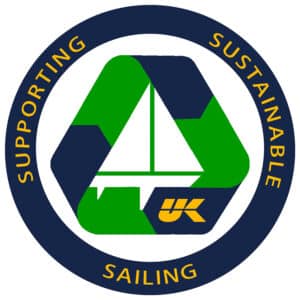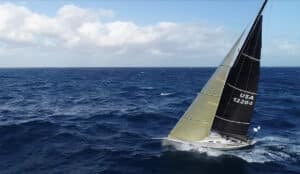A while ago, we posted an instructional video on the letterbox spinnaker takedown, which is the safest and most controllable way to douse a spinnaker at sea. In the original video, you saw a number of letterbox maneuvers from onboard cameras; but onboard shots don’t always let you see the full scope of the letterbox.
Here is an expanded version of our letterbox video with new, off-the-boat footage. Starting just after the 3-minute mark, we show a Martin 49 doing a bald-headed spinnaker takedown at the end of a race. You know how difficult a bald-headed drop can be without the jib helping blanket the spinnaker as it comes down. Take a look at this drop…it’s perfect. The sail floats behind the main, the sheet led over the boom is far enough aft so it doesn’t bind at the tack, and sail goes straight down the hatch.
Named because this take down looks like mail dropped into the slot in a mailbox. The letterbox takedown has four distinct advantages:
-
First, a letterbox take-down lets you drop a chute in a safe, controlled manner with minimal crew.
-
Second, the letterbox lets you drop the spinnaker without having crew working on the foredeck.
-
Third, because the spinnaker is being pulled over the boom, the sail is kept high with little or no chance of going into the water
-
Finally – because a letterbox lowers the spinnaker through the companionway, the forward hatch can be kept closed and tightly dogged to keep breaking seas out of the boat,
To set-up for a Letterbox takedown,
-
Start by attaching a take-down line to the clew of the spinnaker. This can be a changing sheet or spare line. If jibes are expected before the drop, you can carry the take down line forward and pass it around during the jibe.
-
If the sail isn’t rigged with a dedicated take down line, pull the lazy sheet around to the leeward side.
-
Run the takedown line through the slot between the top of the boom and the foot of the main to a block on the windward rail and the back to a cockpit winch.
-
You may not have many options on where to attach the block, but select a lead far enough behind the shrouds so the spinnaker doesn’t get jammed between the boom and the main’s tack.
On a symmetrical spinnaker boat, the bowman goes out to the end of the spinnaker pole and uses a fid to “spike” the tack shackle, which allows the sail to float back into the mainsail’s wind shadow.
Boats with asymmetrical spinnakers the tack can be released three different ways. First, you can let the tack line run as long as the tack line is long enough for the tack of the say to reach the companion way. The second way is to rig a Martin Breaker, which is a piece of spectra line that goes from the end of the sprit, across the trigger of the snap-shackle and then back down to the sprit. When the tack line is released, the sail lifts high enough against the spectra line which activates the trigger to open the tack shackle. The third and least optimal way is for the bowman to go out onto the sprit to spike the shackle with a fid. This is not recommended offshore.
As the crew pulls the spinnaker in over the boom, someone in the cockpit takes up the slack in the take down line that is around a cockpit winch. The line is held tight in case the crew somehow loses control of the spinnaker. Only after the bulk of the spinnaker is down the company way hatch, is the takedown line released.
The letterbox takedown is a technique to practice, perfect, and use.



